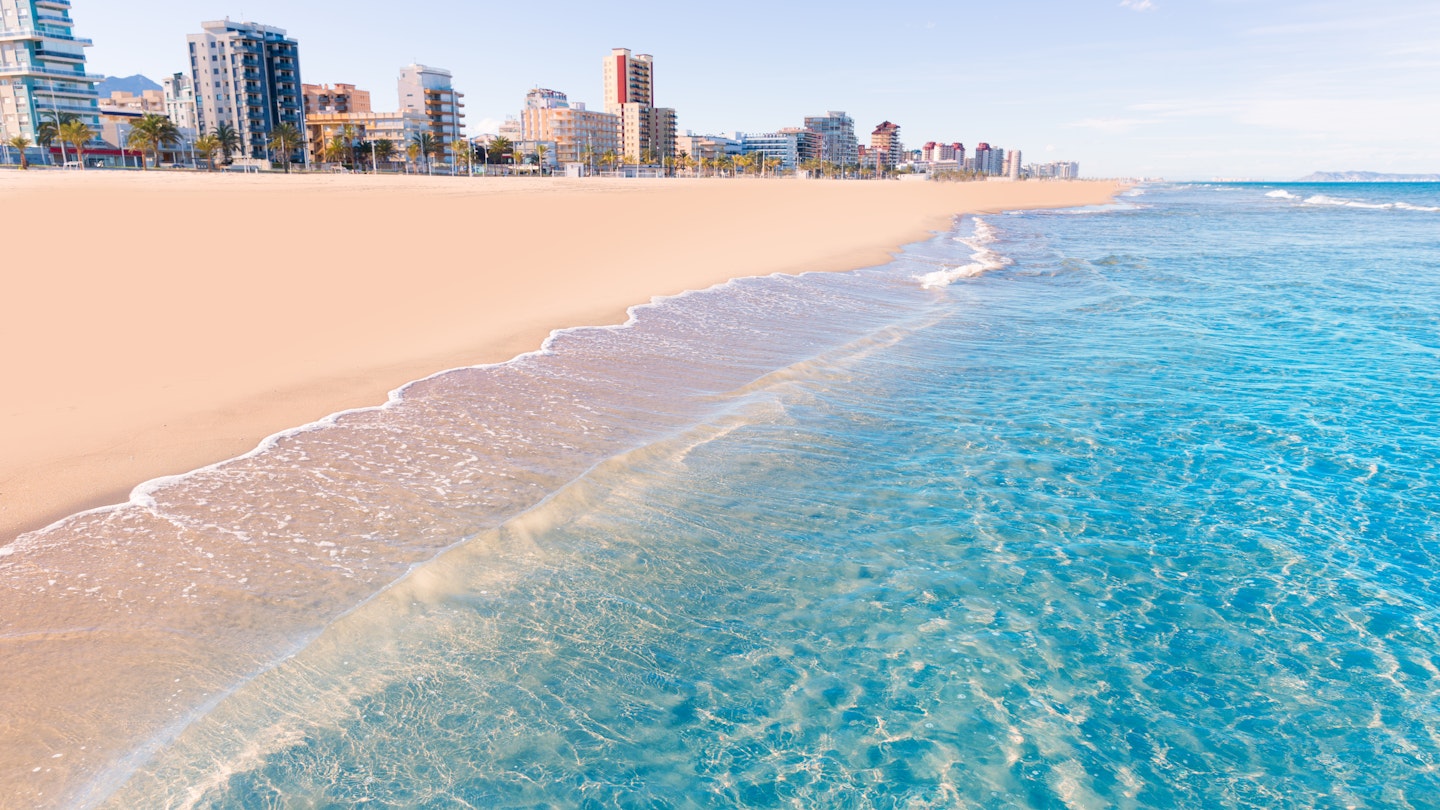In Valencia, you can combine rich culture, phenomenal food, and golden beaches into one fabulous city getaway. This east-coast city’s Mediterranean sands receive the morning sun earlier than almost anywhere else in Spain, and the sea can be warm enough for swimming from April through November.
Valencia’s coastline features an array of sand stretches, coves, and sand dunes, with resorts dotting the shore, confirming its popularity. This diverse coastline caters to everyone: from bustling city beaches filled with locals to serene spots amid wild wetlands, offering water sports, tapas, festivals, and plenty of ice-cold beer.
Unveiling Valencia’s Best Beaches
Playa de Las Arenas
Valencia’s most central beach, Las Arenas, boasts all-around appeal. This broad sandy stretch gently slopes toward the Mediterranean, featuring beachside restaurants serving up delicious paella during summer, where nightlife thrives until dawn. Visitors enjoy volleyball, sun loungers, and bars along the beach, while swimmers and active types engage in SUP (stand-up paddleboarding), sailing, and windsurfing in the water.
After soaking in the sun, discover El Cabanyal, a charming fishing barrio behind Las Arenas, known for its attractive tiled buildings, a rice museum, and excellent backstreet tapas bars like Casa Montaña. Just south, the modern marina hosted the Americas Cup and European Grand Prix, while other beaches, including Malvarrosa, lie to the north.

Playa de la Malvarrosa
Heading north from Las Arenas, you’ll arrive at Malvarrosa beach. This long, wide stretch of sand, featuring an extensive promenade, generally offers a quieter, more relaxed atmosphere compared to Las Arenas. It’s an ideal spot for those seeking a brief escape from the tourist trail while still having access to amenities like toilets and city buses.
Named after the mallow flower that previously grew in the area, Malvarrosa has a few restaurants along the promenade ([La Murciana](https://restaurantelamurciana.com/) is a good choice for tapas and seafood). The main activities here revolve around sunbathing and enjoying the warm waters.
Playa de Patacona
Further north lies Patacona, part of Alboraya, a town integrated into the city suburbs. This beach is quieter than its counterparts, providing a spacious feel and cleaner waters away from the port. You might witness tranquil mornings here as the sun rises, with riders strolling past palm trees.
Several beachfront restaurants are available, and a 25-minute walk inland will lead you to Alboraya, famous for its traditional horchata, a creamy drink made from tiger nuts.
Playa de Pinedo
As the closest beach to the south of Valencia, Pinedo lies across from the port, providing a more sheltered experience than many other southern beaches. It features a designated pet area at the northern end and a nudist section to the south, with water sports available in the Turia river. The beach buzzes with local life, showcasing family picnics, couples sauntering, and vendors selling fried fish.
Just south of Pinedo is L’Arbre del Gos, a quieter stretch ideal for leisurely walks. While facilities are more limited here, visitors can enjoy local activities like go-karting.
The Best of the Southern Beaches
Venturing further south from Valencia uncovers wilder landscapes. El Saler beach, located 13 km from the city, offers various water sports amidst a backdrop of lush pine trees. Following that, La Garrofera beach reveals picturesque grass and rolling dunes alongside its soft sands, while La Devesa beach, beyond the city limits, is adjacent to the Albufera lagoon, Spain’s largest.
These southern shorelines are conveniently reachable from the city center (La Devesa is about a 30-minute drive), allowing visitors to enjoy quality beach time alongside exploring nature. Activities include birdwatching, cycling, walking among sand dunes, visiting scenic viewpoints, and discovering the birthplace of paella, returning to the city well before the locals begin their night out.

Other Great Beaches Near Valencia
Superb beaches also await further afield. Southward lies the Costa Blanca, featuring Playa de Gandia, known for its expansive, resort-laden sands and an attractive 16th-century quarter further inland. Nearby, Dénia and Xàbia are home to alluring, secluded coves along the coastline.
To the north, the Costa del Azahar showcases Sagunto, with its expansive sands and rich history (don’t miss the medieval castle). Beyond Sagunto, Benicàssim is a charming resort town known for its famous aqua park and renowned alt-rock and dance festival. Peñíscola, with its stunning landscape and charming old town, overlooks a slim but beautiful beach.

How to Reach Valencia’s Best Beaches
Many beautiful beaches are easily accessible from the city center. Metrovalencia lines 4 or 8, as well as buses 1, 2, 19, 31, or 32, serve Las Arenas and the nearby beaches. Meanwhile, buses 14 or 15 connect to the secluded southern beaches.
Taxis or cars can significantly save travel time, especially to the southern beaches; alternate local transport options include Cabify. Furthermore, trains and intercity buses offer convenient connections from Valencia to Playa de Gandia and Benicàssim, perfect for day trips or overnight stays.
Moreover, a refreshing option to reach city beaches involves following the Jardines del Turia, a captivating series of gardens lining the old riverbed from the heart of Valencia to the port. This bike ride or stroll leads to attractions like the Ciudad de las Artes y las Ciencias and Gulliver.
All city beaches provide various amenities, including restaurants, toilets, and showers. However, facilities can be limited on more remote beaches. Thus, bringing water and sunblock is always advisable.





